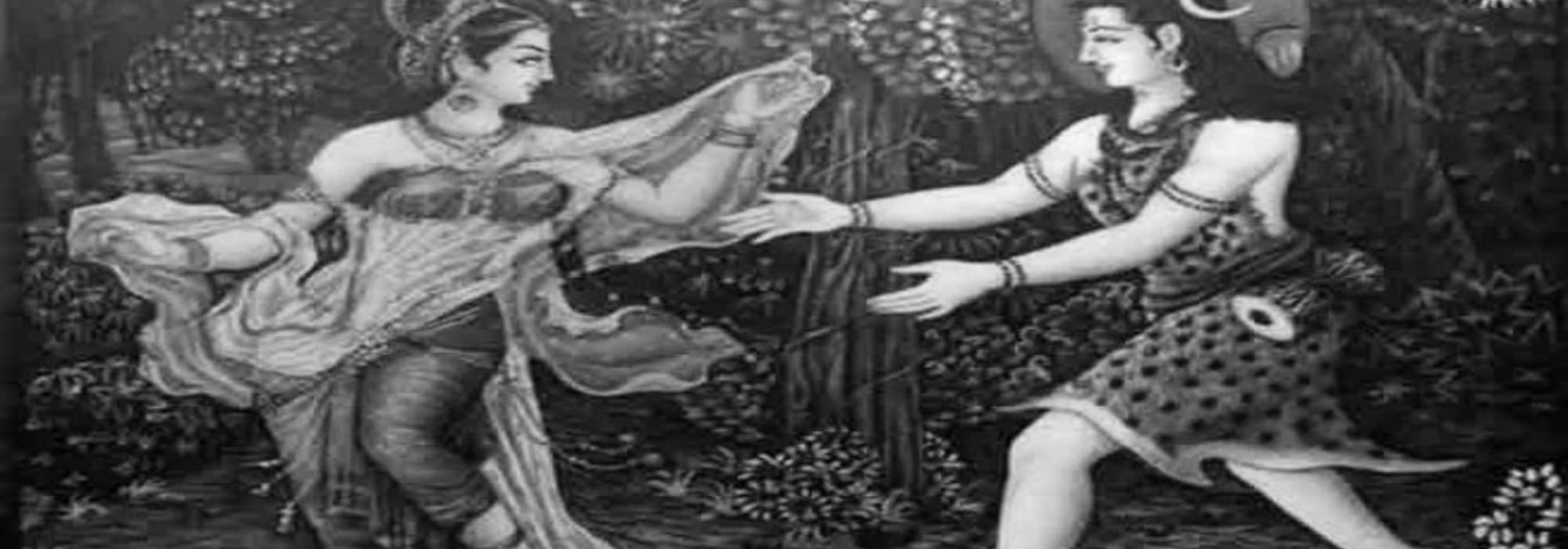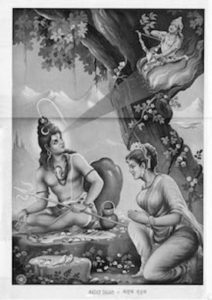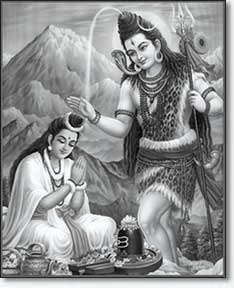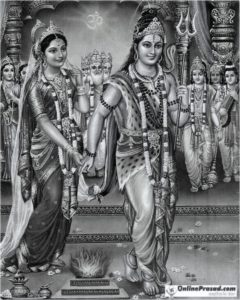Kumārasambhavam
The epic opens with a magnificent hyperbole describing the great Himalayan mountains:
स्थितः पृथिव्या इव मानदण्डः ||
The Himalayas is like a great measuring scale used to measure the earth.
The narrative then moves to describing his daughter Pārvatī. We can look at a few descriptions of Pārvatī.
प्रभामहत्या शिखयेव दीपस्-
त्रिमार्गयेव त्रिदिवस्य मार्गः |
संस्कारवत्येव गिरा मनीषी
तया स पूतश्च विभूषितश्च ||
The Himalayas was both sanctified as well as decorated by his daughter Pārvatī. She was to him like a bright flame is to a lamp; like the river Gaṅga is to the paths of the heavens and like a refined language is to the intellect.
सर्वोपमाद्रव्यसमुच्चयेन
यथाप्रदेशं विनिवेशितेन |
सा निर्मिता विश्वसृजा प्रयत्नाद्-
एकस्थसौन्दर्यदिदृक्षयेव ||
By being the measure of every kind of beauty imaginable and the appropriateness of it, Pārvatī was like the result of the creator’s desire to see all the beauty of the universe in one place.
And then, when the gods approach Lord Brahmā to help them overcome the demon Tārakāsura, Lord Indra implores his preceptor Bṛhaspati to commence the request.
ततो मन्दानिलोद्धूत
कमलाकरशोभिना |
गुरुं नेत्रसहस्रेण
चोदयामास वासवः ||
And then, like the multitude of lotuses swayed by a pleasant breeze blowing over the lake, Lord Indra’s thousand eyes were seen imploring his preceptor to narrate the perilous situation of the gods.
उच्चैरुच्चैःश्रवास्तेन
हयरत्नमहारि च |
देहबद्धमिवेन्द्रस्य
चिरकालार्जितं यशः ||
The great white horse of Indra, Uccaiḥśravās, which was like the personification of Indra’s fame, was taken away from him by Tārakāsura.
गोप्तारं सुरसैन्यानां
यं पुरस्कृत्य गोत्रभित् |
प्रत्यानेष्यति शत्रुभ्यो
बन्दीमिव जयश्रियम् ||
We seek a protector, under whose leadership Indra shall win back his power and prosperity as if he would be releasing them from enemy captivity.
And then, the gods employ the services of Kāma, the lord of love, to try and create love between Lord Śiva and Pārvatī. He is supported by his friend, the spring season.
सद्यःप्रवालोद्गमचारुपत्रे
नीते समाप्तिं नवचूतबाणे |
निवेशयामास मधुर्द्विरेफान्
नामाक्षराणीव मनोभवस्य ||
The arrows of Kāma were made from the budding leaves of the mango tree. The bees lined up on them appeared like the letters making up the name of Kāma himself.
Here, Kālidāsa has utilized the historical fact of warriors inscribing their names on their arrows to such dramatic and beautiful effect.
As he approaches Lord Śiva, Kāma develops cold feet and loses all confidence. At that time, Pārvatī appears on the scene.
पर्याप्तपुष्पस्तबकावनम्रा सञ्चारिणी पल्लविनी लतेव ||
Pārvatī appeared like a moving creeper in full bloom.
Her beauty emboldens Kāma.
कामस्तु बाणावसरं प्रतीक्ष्य
पतङ्गवद्वह्निमुखं विविक्षुः |
उमासमक्षं हरबद्धलक्ष्यः
शरासनज्यां मुहुराममर्श ||
Kāma, making sure everything is right with his bow, waited for the right moment to strike his floral arrow at Śiva. He was like an insect unknowingly rushing towards a burning flame.
Kāma eventually strikes his arrow at Śiva and even the great lord is stirred for a moment.
हरस्तु किञ्चित्परिलुप्तधैर्यश्चन्द्रोदयारम्भ इवाम्बुराशिः |
Śiva got stirred for a moment. It was like the sea which experiences high tide during moon-rise.
But Lord Śiva quickly regains composure and burns Kāma to ashes.
तमाशु विघ्नं तपसस्तपस्वी
वनस्पतिं वज्र इवावभज्य |
स्त्रीसंनिकर्षं परिहर्तुमिच्छन्न्
अन्तर्दधे भूतपतिः सभूतः ||
Thus, having swiftly crushed Kāma, the menace to his penance, like lightening striking down a tree, Lord Śiva decided to shun the presence of women altogether and disappeared with his companions.
This simile is apt because, when lightning strikes a tree, it gets burnt down to ashes just like Kāma was.
Rati, wife of Kāma, weeps over his ashes.
अथ सा पुनरेव विह्वला
वसुधालिङ्गनधूसरस्तनी |
विललाप विकीर्णमूर्धजा
समदुःखामिव कुर्वती स्थलीम् ||
She wailed for her husband lying on the ground, her clothes all soiled and her hairs dishevelled. It was appearing as she was moving that entire place into grief.
गत एव न ते निवर्तते
स सखा दीप इवानिलाहतः |
अहमस्य दशेव पश्य माम्
अविषह्यव्यसनप्रधूषिताम् ||
Gone are you and won’t be returning; you are like a lamp put out by wind. I am like the wick of that lamp which can only fume in despair.
विधिना कृतमर्धवैशसं
ननु माम् कामवधे विमुञ्चता |
अनघापि हि संश्रयद्रुमे
गजभग्ने पतनाय वल्लरी ||
Fate has half-killed me by snatching Kāma away from me. I am like that creeper which has been pulled down because the tree I was clinging on to was pulled down by an elephant.
Thus despairing, Rati decides to end her own life. Then, a voice from the heavens assures her that Kāma will be resurrected.
शफरीं ह्रदशोषविक्लवां प्रथमा वृष्टिरिवान्वकम्पयत् |
That voice shook her up like the first rains which shake up the anxious fishes in the near-empty ponds.
In the meanwhile, Pārvatī decides upon penance to earn the love of Lord Śiva. Her mother tries to prevent her. A beautiful selection from there falls into the category dṛṣṭānta, or analogy.
मनीषिताः सन्ति गृहेऽपि देवतास्-
तपः क्व वत्से! क्व च तावकं वपुः |
पदं सहेत भ्रमरस्य पेलवं
शिरीशपुष्पं न पुनः पतत्रिणः ||
All the gods that you can think of reside in our home. Why do you need to do penance? The hard ways of penance are not made for a delicate darling like you. A flower can only tolerate the weight of a bee; not of a bird.
Pārvatī nevertheless decides to go ahead with penance. And eventually, Lord Śiva is pleased with her penance and comes to meet her in the guise of a young brahmacāri. He tests the love of Pārvatī and when she rings true in every test, he eventually presents himself in his true form and holds her by her hand.
तं वीक्ष्य वेपथुमती सरसाङ्गयष्टिर्-
निक्षेपणाय पदमुद्धृतमुद्वहन्ती |
मार्गाचलव्यतिकराकुलितेव सिन्धुः
शैलाधिराजतनया न ययौ न तस्थौ ||
Seeing him in such an unexpected manner, Pārvatī could neither stay put nor move. She was like a river which had encountered a mountain in its path and is struggling to find a way past it.
Then, Pārvatī sends forth her friend to inform Lord Śiva about approaching her father to seek her hand in marriage.
तया व्याहृतसन्देशा
सा बभौ निभृता प्रिये |
चूतयष्टिरिवाभ्याष्ये
मधौ परभृतामुखी ||
Thus, by sending the message and staying silent herself, Pārvatī appeared like a mango tree which sends forth its message of love to the spring season through the cuckoo.
Lord Śiva, on his part, requests the seven great sages, saptaṛṣis, to approach the mountain-king Himavat on his behalf. They, along with Arundhatī, set forth on their mission.
तेषां मध्यगता साध्वी
पत्युः पादार्पितेक्षणा |
साक्षादिव तपःसिद्धिर्-
बभासे बह्वरुन्धती ||
Arundhatī, the devoted wife of the great sage Vasiṣṭha, shone in the midst of the seven sages as if she was the living fruit of their penances.
The great Himalayas is humbled by their arrival.
मूढं बुद्धमिवात्मानं
हैमीभूतमिवायसम् |
भूमेर्दिवमिवारूढं
मन्ये भवदनुग्रहात् ||
By your grace, I feel like a dullard suddenly becoming knowledgeable or like iron turning into gold or like a mere mortal raised straight up to the heavens.
The saptaṛṣis likewise compliment the mountain-king.
मनसः शिखराणां च सदृशी ते समुन्नतिः ||
Your thoughts are as tall as your peaks.
And finally, they request him to marry his daughter to Lord Śiva.
तमर्थमिव भारत्या सुतया योक्तुमर्हसि |
Just like a word and its meaning are inseparably coupled with each other, so shall you couple Lord Śiva to your daughter Pārvatī.
Eventually, Lord Śiva and Pārvatī get married in grand ceremony at the great Himalayas. And the epic concludes with Pārvatī becoming pregnant. There are a number of beautiful similes in Kālidāsa’s other works also. The interested reader can enjoy them all by visiting the original or a faithful translation.
















































